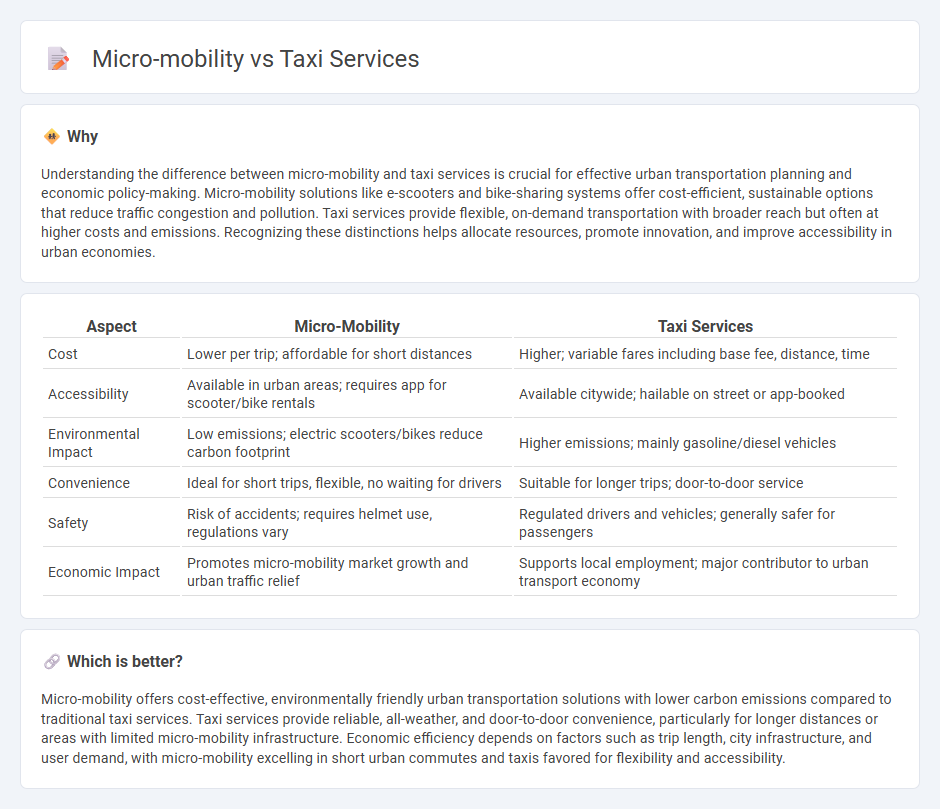
Micro-mobility solutions, including e-scooters and bike-sharing, offer cost-effective, environmentally friendly alternatives to traditional taxi services in urban areas. These options reduce traffic congestion and lower carbon emissions while providing convenient last-mile transportation. Explore how micro-mobility is transforming urban economies compared to conventional taxi models.
Why it is important
Understanding the difference between micro-mobility and taxi services is crucial for effective urban transportation planning and economic policy-making. Micro-mobility solutions like e-scooters and bike-sharing systems offer cost-efficient, sustainable options that reduce traffic congestion and pollution. Taxi services provide flexible, on-demand transportation with broader reach but often at higher costs and emissions. Recognizing these distinctions helps allocate resources, promote innovation, and improve accessibility in urban economies.
Comparison Table
| Aspect | Micro-Mobility | Taxi Services |
|---|---|---|
| Cost | Lower per trip; affordable for short distances | Higher; variable fares including base fee, distance, time |
| Accessibility | Available in urban areas; requires app for scooter/bike rentals | Available citywide; hailable on street or app-booked |
| Environmental Impact | Low emissions; electric scooters/bikes reduce carbon footprint | Higher emissions; mainly gasoline/diesel vehicles |
| Convenience | Ideal for short trips, flexible, no waiting for drivers | Suitable for longer trips; door-to-door service |
| Safety | Risk of accidents; requires helmet use, regulations vary | Regulated drivers and vehicles; generally safer for passengers |
| Economic Impact | Promotes micro-mobility market growth and urban traffic relief | Supports local employment; major contributor to urban transport economy |
Which is better?
Micro-mobility offers cost-effective, environmentally friendly urban transportation solutions with lower carbon emissions compared to traditional taxi services. Taxi services provide reliable, all-weather, and door-to-door convenience, particularly for longer distances or areas with limited micro-mobility infrastructure. Economic efficiency depends on factors such as trip length, city infrastructure, and user demand, with micro-mobility excelling in short urban commutes and taxis favored for flexibility and accessibility.
Connection
Micro-mobility and taxi services complement urban transportation by offering flexible, last-mile connectivity options that reduce traffic congestion and carbon emissions. Integrating electric scooters, bikes, and ride-hailing platforms enhances accessibility and convenience, promoting seamless multimodal travel within cities. Data-driven coordination between these services optimizes route efficiency and meets diverse mobility demands, boosting the overall economy through improved urban mobility infrastructure.
Key Terms
Market Segmentation
Taxi services primarily cater to urban commuters seeking convenient, door-to-door transportation with a focus on comfort and reliability, serving business travelers, tourists, and non-drivers. Micro-mobility targets environmentally conscious, short-distance travelers, including young adults and daily commuters, offering cost-effective, flexible solutions like e-scooters and bike-sharing. Explore deeper insights into market segmentation trends and consumer preferences to understand the evolving transportation landscape.
Cost Structure
Taxi services incur higher fixed costs due to vehicle maintenance, driver wages, and licensing fees, while micro-mobility options such as e-scooters and bike-sharing benefit from lower operational expenses and reduced infrastructure investments. Variable costs in taxis fluctuate with fuel consumption and ride frequency, whereas micro-mobility platforms optimize costs through scalable charging and redistribution systems. Explore detailed cost structure comparisons to understand the economic efficiencies driving urban transportation choices.
Urban Mobility
Taxi services offer flexible, on-demand transportation with door-to-door convenience, catering to diverse urban travel needs and longer distances. Micro-mobility options, including e-scooters and bike-sharing, provide eco-friendly, cost-effective solutions for short trips, reducing traffic congestion and emissions in dense urban centers. Explore how integrating taxi services and micro-mobility can transform urban mobility strategies for smarter, sustainable cities.
Source and External Links
Taxi Services in Corvallis - INTO OSU - Taxi services in Corvallis typically charge a flat base rate plus about $2.50 per mile, with additional fees for wait times; local companies include Hub Cab, Beaver Cab, and Ali Taxi, among others.
Portland Taxi Services Cabs to Airport Radio Cab Near Me - Radio Cab offers 24/7 taxi services in Portland with professional drivers, affordable rates, and convenient booking options, serving locations including Portland International Airport and downtown areas.
Taxis, Limousines and Shuttle Services | PHL.org - Philadelphia International Airport provides readily available taxicabs at Zone 5 on the S. Commercial Roadway, along with limousine and van services at Zone 6, offering access to the metro area and surrounding counties.
 dowidth.com
dowidth.com